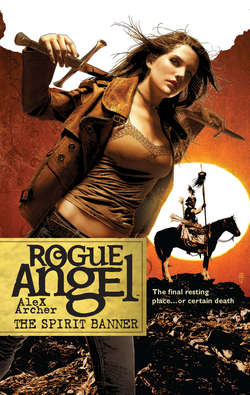Читать книгу The Spirit Banner - Alex Archer - Страница 14
8
ОглавлениеAnnja was quickly engrossed in her work, so much so that she never even noticed when Davenport gestured to Mason and the two of them slipped out of the room behind her back.
The book had been handwritten in Latin in a thin, spidery script. The pages were faded and, in some cases, heavily stained, making it difficult to understand certain passages, but for a seven-hundred-year-old book it was remarkably well preserved.
She began to read.
The book was exactly what Davenport had claimed—the personal journal of a man who’d endured a long and arduous journey deep onto the Mongolian steppes on behalf of the church. Curran was an excellent writer and she soon found herself drawn into the story itself. She could sense the man’s loneliness, could feel his determination to do the job right and return home. She even ached along with him when his only companion succumbed to his wounds and died in the middle of the night. Curran’s death must have been sudden, for he hadn’t made any reference to the coming end in his journal. One day he was writing about trying to dig himself out and then the next, nothing.
She read through the entire work once, start to finish, looking for glaring problems that would instantly tell her the document was a fake. When she didn’t find any, she settled in for a more intricate examination.
The first thing she did was look for historical inaccuracies. She’d once examined a manuscript supposedly written by a Catholic priest who’d accompanied Vasco da Gama on his famous journey around the Cape of Good Hope. It had been an excellent forgery; the paper had passed the radiocarbon test, the text had been written in the dialect spoken in the area where the priest had supposedly lived at the time, even the ink had been correctly aged. The whole charade had only fallen apart when Annja reached the last page of the manuscript. The forger had added the words Societus Iesu , Latin for Society of Jesus, after the writer’s signature. Apparently he hadn’t done his homework on that little addition, for the Jesuits, a Catholic order founded by St. Ignatius of Loyola, wouldn’t come into being until fifty years after the events portrayed in the manuscript.
The trouble was that not only were Curran’s observations historically correct, as nearly as she could tell, such as the location of Guyuk’s summer encampment and the establishment of trade with parts of China, but they contained many small details that the average forger more than likely wouldn’t be aware of at all. Things like the stench that hung over the Mongol army at all times in the field due to their reluctance to bathe in rivers and streams, or the way Mongol horsemen would smear their exposed skin with yak grease to take the bite out of the winter wind on the high plains.
She stopped looking for historical errors after a few hours and turned instead to linguistic ones. Language grows and changes, just like any other organic element, and a good historian can also spot a forgery by the way certain words or phrases are used within a text.
Annja struck out there, too.
Her doubts about the authenticity of the manuscript were starting to take a beating in the face of what she was reading. So far, the manuscript had passed every test.
Knowing she’d been at it for hours, she got up and stretched a bit. She noticed a small serving tray had been left by the door at some point, and lifting the lid she discovered a plate of turkey sandwiches, complete with cranberry sauce and a bed of lettuce, along with a soft drink that was still icy cold. She gratefully dug in.
When she finished eating, she decided to give the text a rest and turn her attention to the map that had been hand drawn in the back of the journal.
She was in the midst of rereading the document for the sixth or seventh time when she saw a key piece of the puzzle. Several words on the page started with a funny little curlicue, as if the writer had left the pen on the page for a few seconds too long. At first, she thought it was just an artifact of the particular pen the author had used. Perhaps its point hadn’t been cut properly and the ink had pooled where it shouldn’t have. But then she began to notice that there wasn’t a consistency to its appearance. On one page a word starting with the letter T would have the little curlicue, but two pages later the same word would not.
Curious, she went back to the beginning and began to flip through the images of each page, looking for the strange little mark. Her trained eye began to pick out a pattern to its occurrences, something a little less than random.
“That’s interesting,” she told the empty room around her.
Grabbing a piece of paper, she went back to the beginning of the text again, but this time she wrote down every word where the strange mark appeared. She listed them in a vertical column, one after another, until she had reached the end. Scanning down the list, she quickly noted that the words seemed to form sentences and so she rewrote them in horizontal lines instead, guessing where one sentence left off and another one began. When she was finished, she was left with several paragraphs of text.
Her eyes widened as she realized what they were.
